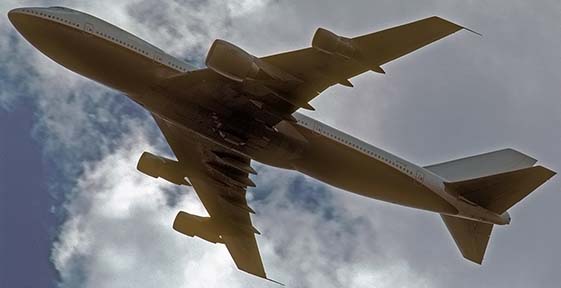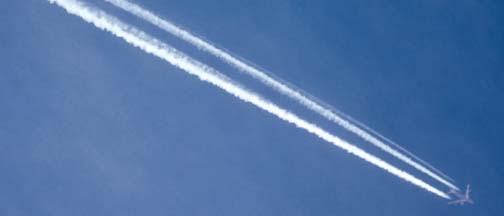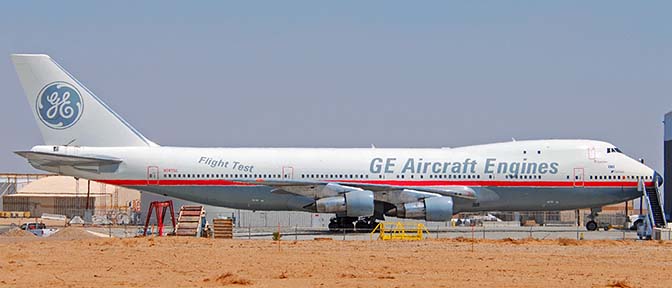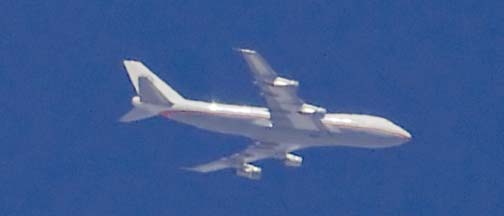
Boeing 747-121 General Electric Engine Testbed, c/n 19651 |
For a number of years, General Electric has used a former Pan Am 747-121 as an engine testbed.
General Electric's 747-121 Engine Testbed carries construction number 19651 and was the 25th 747 off the production line. It first flew on March 3, 1970. It was delivered to Pan Am as N744PA Clipper Star of the Union on March 21, 1970. It was later rechristened Clipper Ocean Spray. Pan Am retired it on December 4, 1991.
General Electric leased it and registered it as N747GE on March 9, 1992. A variety of engines have been tested on its number-2 pylon, including the GE90-115 and the CF34. It was based at the Mojave Airport for several years before its operations were transferred to the Southern California Air Logistics Center at Victorville in 2002. It is the oldest 747 that is still flown.
 747-121 General Electric GE90 Engine Testbed, N747GE over Kramer Junction, California on August 24, 1999.
747-121 General Electric GE90 Engine Testbed, N747GE over Kramer Junction, California on August 24, 1999.
 Over Kramer Junction, California on August 24, 1999.
Over Kramer Junction, California on August 24, 1999.
 Over Kramer Junction, California on August 24, 1999.
Over Kramer Junction, California on August 24, 1999.
 General Electric's Boeing 747
engine testbed, N747GE over the Saline Valley in March 2003 while it was testing a 115,000-pound thrust GE90-115B engine. Note the large contrail issuing from the number 2 engine and the very small contrail from the number 4 engine.
General Electric's Boeing 747
engine testbed, N747GE over the Saline Valley in March 2003 while it was testing a 115,000-pound thrust GE90-115B engine. Note the large contrail issuing from the number 2 engine and the very small contrail from the number 4 engine.
General Electric's press release about the first flight of the 747 with the GE90-115B.
 N747GE prepares to depart from Victorville to Fairbanks, Alaska on August 5, 2007.
N747GE prepares to depart from Victorville to Fairbanks, Alaska on August 5, 2007.
 N747GE flies over the Saline Valley on April 9, 2010.
N747GE flies over the Saline Valley on April 9, 2010.
Gene Tyler Sendlewski provided this History of the General Electric Boeing 747 Flying Test Bed:
Construction number 19651 was the 16th 747 built at Boeings Everett Washington Plant. This 747 was fitted with four Pratt & Whitney JT90-7A engines and made its first flight on March 3, 1970.
On March 21,1970 Boeing delivered its 25th 747 to Pan American Airways. Pan Am registered the 25th 747 as N744PA, it named the new 747-121 the "Clipper Star of the Union" and later re-named it "Clipper Ocean Spray". In June 1981, because of the high inflation of the late 1970's Pan Am hit hard times and sold the Boeing 747 to the Wilmington Trust Company. Pan Am leased the aircraft back from Wilmington Trust. In 1991 Pan American airlines went bankrupt and Wilmington Trust company re-possessed the Boeing 747 aircraft from Pan Am.
On March 9,1992 the former Pan Am Boeing 747-121 was registered to General Electric Aircraft Engines (GEAE) at the Mojave Airport
in Mojave, California. At the Mojave Airport General Electric removed all
passenger coach seating from the former Pan Am 747 and installed three engine
data-gathering systems. General Electric strengthened the 747-100 airframe to
allow it to be capable of flying 747-300 type maneuvers, needed for high - inlet -
angle, fan - stress and inlet - stability testing. GEAE would attach the test engine
to the number two engine pylon located on the aircrafts left wing. Some of the
engines that GEAE wanted to test on the test bed were bigger and heavier then
the Pratt & Whitney JT9D-7A engines originally installed on the 747. So to test
bigger and heavier engines with a higher thrust level, GEAE reinforced the
center fuselage and the left wing of the aircraft. GEAE also rebuilt section 41
on the forward fuselage of the aircraft because it was a common weak spot on
all Boeing 747-100 airframes. The new customized 747 test bed, unlike other older and smaller GEAE test beds can process all of the test information aboard the aircraft during flight.
The GE90 made its first flight on the test bed in December 1993. The
GE90 is used on such airframes as the Boeing 777-200, 777-200ER, 777-200LR
777-300ER, 777-Freighter and some Boeing 767's.
In 2002 General Electric Aircraft Engines Purchased the Boeing 747-121
it was leasing from Wilmington Trust, GEAE now owned the test bed.
GEAE's next new ground braking engine would be the GEnx engine, which was based off the GE90 with its composite technology. Before the GEnx engine could be used on the GEAE test bed, the test bed had to be upgraded. GEAE moved the home of the GEAE test bed from the Mojave Airport in Mojave, CA to Southern California Logistics Airport in Victorville, CA. GEAE built a new $15 million dollar 161,700sq.ft hangar facility to store the 747 test bed and the site is also used for engine research. The facility opened in 2004 and began upgrading the flying test bed to handle the GEnx engine. Electrical work was needed to supply the GEnx engine with sufficient power for starting, the electrical work was completed in January 2007. On February 22,2007 the GEAE GEnx engine made its maiden flight on the Boeing 747 test bed. Two GEnx flight test programs were conducted using the 747 flying test bed, the GEnx-1B program and the GEnx-2B program. The GEnx-1B will be used on the new Boeing 787 Dreamliner and the GEnx-2B will be used on the new Boeing 747-8 Intercontinental and Freighter aircrafts. The GEnx engine has also been ordered for the Airbus A350. Nine GEnx test engines were used on the flying test bed for flight testing. GEAE used the flying test bed to test fly the GEnx engine three times a week for three months to test and evaluate the engine GE tested air re-starting, combustor operations margins, throttle, response's, nacelle and undercowl cooling.
Hot day testing was tested at Yuma, Arizona, General flights were flown out of Victorville, California and high - altitude take off flights were flown out of Colorado Springs, Colorado.
Flight testing on the GEnx-1B was completed after four months and 187 test flight hours, in June 2007. The GEnx-2B engine was tested on the GEAE test bed during 2008, the program was made up of five engines and will concluded in early 2009.
GEAE also tested an oddball engine on the 747 test bed in 2003-2004 it was the GEAE CF34-10 engine, it made total of 23 flights on the test bed. this was a small engine, compared to other engines tested on the test bed and is employed on the ARJ21 regional jets.
The GEAE 747 flying test bed is one of the most high tech test beds for engine testing in the industry and will continue test GEAE and other engines out of GEAE's Victorville facility for years to come.
You can buy a 2020 calendar
featuring my photographs of Boeing Testbeds. A dozen photos of Boeing Testbeds. Aircraft pictured include:
You can buy a 2020 calendar
featuring my photographs of Giant Airplanes.
Go to the home page of the Goleta Air
and Space Museum. Send a message to Brian. The General Electric Aircraft Engines flying test bed is a Boeing
747-121 with the construction number 19651 and was the 25th 747 built by Boeing. Before General Electric acquired there 747 test bed, it was operated by Pam American airlines, On December 22,1965 Pan Am and Boeing announced they proposed specifications for a wide body airliner called the 747 and Pan AM proposed an order of 25 of the new wide body aircraft. On July 25,1966 Boeing announced that it would go ahead with the 747 project. Pan Am ordered twenty five Boeing 747's for $525 million and construction number 19651 (the future GE test bed) was apart of that order.
- advertisement -
Boeing Testbeds
2020 Calendar
General Electric 727-63 Unducted Fan Testbed N32720, Mojave Airport, November 9, 1986,
NT-43A Radar Test Bed 73-1155, Death Valley, January 24, 2003,
U. S. Air Force YAL-1A Airborne Laser 01-0001, Boron, California, March 29, 2005,
U. S. Army 767-200 Airborne Surveillance Testbed N767BA, Victorville, California, June 17, 2005,
Australian Air Force 737-7ES N378BC Wedgetail Airborne Early Warning & Control, Victorville, California, July 9, 2005,
757-200 F-22 Avionics Testbed N757A, Air Force Plant 42, Palmdale, California, February 13, 2006,
Evergreen International 747-273C Supertanker N470EV, San Bernardino, May 31, 2006,
NASA 747SP-21 N747NA Stratospheric Observatory for Infrered Astronomy (SOFIA), Boron, California, May 31, 2007,
General Electric 747-121 Engine Testbed N747GE, Victorville, California, August 5, 2007,
Honeywell 720-051B Trent 1000 testbed N720H, Phoenix Sky Harbor International Airport, December 27, 2007,
Rolls Royce 747-257B Engine Testbed N787RR, Tucson, Arizona, March 4, 2018,
Honeywell 757-225 engine testbed N757HW, Phoenix Sky Harbor International Airport, April 19, 2018,
 Put a copy of the Boeing Testbeds: 2020 Calendar in your Lulu.com shopping cart for $14.95.
Put a copy of the Boeing Testbeds: 2020 Calendar in your Lulu.com shopping cart for $14.95.
Giant Airplanes
2020 calendar
Coulson Flying Tankers Martin JRM C-FLYL Hawaii Mars, Lake Elsinore, California, October 27, 2007,
NASA Boeing 747-123 Shuttle Carrier Aircraft N905NA/Endeavour, Edwards Air Force Base, December 10, 2008,
Lockheed C-5B Galaxy 87-0032, Nellis Air Force Base, April 25, 1997,
Volga-Dnepr Antonov An-124 RA-82068, Phoenix, Sky Harbor, June 15, 2016,
Saudi Arabian Boeing 777-368ER HZ-AK17, Los Angeles International Airport, January 19, 2015,
Delta Boeing 747-451 N668US, Phoenix Sky Harbor, January 8, 2016,
Antonov An-225 Mriya UR82060, Zhukovsky, Russia, September 3, 1993,
American Airbus A330-323 N273AY, Phoenix Sky Harbor, December 20, 2017,
Virgin Atalntic Airbus A340-642 G-VWKD, Los Angeles International Airport, January 19, 2015,
Asiana Airbus A380-800 HL7625, Los Angeles International Airport, May 3, 2016,
Lufthansa Boeing 747-830 D-ABYK, Los Angeles International Airport, January 19, 2015,
All Nippon Airlines Boeing 787-9 JA837A, Phoenix Sky Harbor, January 28, 2018,
 Put a copy of the Giant Airplanes: 2020 calendar in your Lulu.com shopping cart for $14.95.
Put a copy of the Giant Airplanes: 2020 calendar in your Lulu.com shopping cart for $14.95.
- advertisement -